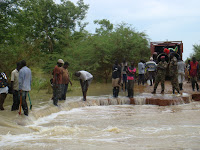After three weeks in Maban, my brain is a jumble of activities ... to give you an idea, here's an account of what's going on.
Here's a map of the main refugee camps in South Sudan. Upper Nile state is where it's at.
If we look at numbers, as of 26 August:
Oxfam GB is providing WASH (Water, Sanitation and Hygiene) in Jamam and Gendrassa camps. Jamam is actually comprised of two camps, aptly named Jamam 1 and Jamam 2 (UNHCR is VERY inventive).
UNHCR continues to relocate refugees from the flooded
but
groundwater-scarce Jamam 1 camp to Gendrassa. The women and children arrive on big white
buses, the men arrive on lorries with their families' belongings; they
wash their hands at Oxfam's hand washing station, proceed to the UNHCR
registration desk and undergo a health check at IMC's medical point,
before being moved to their new 'home'.
Around 7,000 refugees have been moved from Jamam 1 to Gendrassa. Eventually all 12,000 will be moved; and the camp has enough space to accommodate more, should additional refugees cross the border to flee fighting in Sudan's Blue Nile state. The existing refugees in Jamam 2 camp will remain, and so will we.
ICRC is constructing a 14km pipeline from Bantiko to Jamam 2, to ensure enough water supply for the refugees located there. We have struggled to hit groundwater in Jamam.
The UN's World Food Program is doing daily food drops from huge white planes. The sacks crash to the ground on impact and spray wheat everywhere. There may be a random wheat field growing there next year... the wheat sacks are loaded onto lorries and transported to Gendrassa for distribution to refugees.
Flooding from waters flowing in from the Ethiopian highlands is causing havoc on the road between Jamam and Gendrassa. Last week the road was breached by floodwaters, which stopped the movement of refugees, food and NGO vehicles for a few days while they repaired the road. Food distributions were delayed by a total of six days, a long time to wait when you're already hungry. The repair was the quickest thing I've seen happen in a year in South Sudan. Nice one UNOPS.
It's also extremely wet and muddy. These refugees are living in a swamp. I spent a lot of my time wearing gumboots.
As for Oxfam GB, here are some of the activities going on in Gendrassa and Jamam 1 & 2 refugee camps:
- Oversight of the hand washing station set up at the Gendrassa registration point
- Drilling of boreholes to provide water for refugees (Gendrassa has higher yield boreholes to which we can either install handpumps, or submersible pumps, tanks and tap stands)
- Daily water trucking from Bangketa and Bantiko boreholes to Jamam 1 & 2 camps
- Cholera and malaria prevention campaigns (particularly the former after a potential cholera outbreak scare) and a Hepatitis E prevention campaign (after a MSF-confirmed outbreak of the disease) through the use of volunteers from the refugee community
- Monitoring of volunteers' activities and spot checks on the cleanliness of latrines and water points
- Daily monitoring of households to identify health and hygiene issues and practices, availability of soap, cleanliness of drinking water ...
- Distributions of soap, buckets and plastic sheeting to enable households to build bathing shelters
- Distribution of aquatabs, water maker and PUR sachets ... all necessary water treatment methods, as refugees continue to take contaminated water from the river rather than the chlorinated water we are providing in our tanks and boreholes. They don't like the taste.
- Construction of emergency communal 'trench' latrines (constructed from plastic sheeting and wood, 6 slabs are built over a long trench, essentially resulting in a block of 6 latrines)
- Employment of latrine attendants to keep communal latrines clean and ensure hand washing stations are topped up with water and soap (and to keep the goats from eating the soap)
- A transitional process from communal trench latrines to household latrines (with the subsequent challenge of finding enough wood to construct them without decimating the local trees) so that each plot (one for each family) has their own latrine, or shares one between 3 or 4 households
- Meetings with sheikhs and umdas (chiefs and paramount chiefs) to communicate messages to the households in their care.
I am tired.










No comments:
Post a Comment